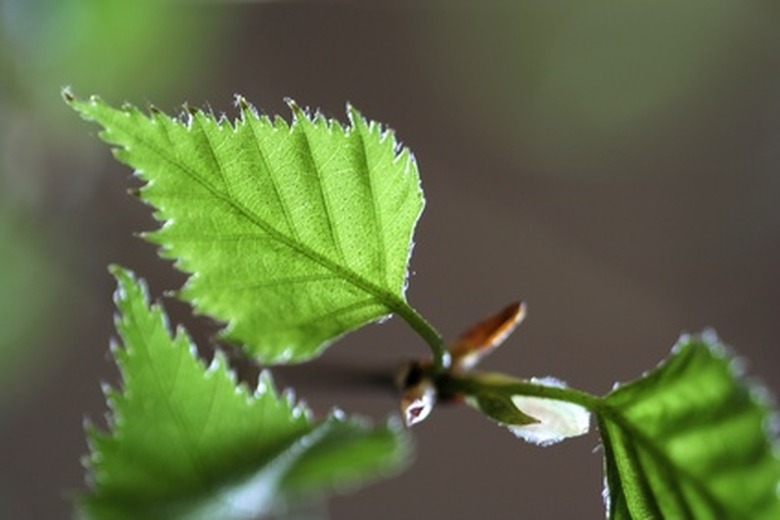Birch Tree Leaf Identification
You can find the majority of birch species in the cooler environs of the northern hemisphere, according to "Trees of North America." The birches are important ornamental species, in no small part because of their foliage. The leaves of the birches have some interesting shapes and can provide vivid autumn displays of color. Identification of the birch leaves comes from possessing knowledge of their assorted features.
Size
Birch leaves are not large, as the foliage of trees such as oaks and maples tends to be, with most only a few inches in length. For instance, the average white birch leaf grows to be about 2 to 3 inches long. Some of the longer birch leaves grow on the yellow birch and sweet birch, at 4.5 inches and 5 inches in length respectively. Yukon birch has leaves that rarely exceed 1 1/2 inches in length, making these leaves among the smallest of all the birches in North America.
- You can find the majority of birch species in the cooler environs of the northern hemisphere, according to "Trees of North America." The leaves of the birches have some interesting shapes and can provide vivid autumn displays of color.
Shapes
Birch leaves are simple in form, with a single blade comprising the leaf. Their shapes vary from the oval form of white birch to the shape that characterizes the river birch. The "National Audubon Society Field Guide to Trees" describes river birch leaves as being "nearly four-sided;" their irregular shape somewhat resembling that of a diamond. Some of the other shapes of birch leaves include the almost triangular outline of gray birch and the oblong form of sweet birch.
Colors
The colors of most birch tree foliage is some shade of green, with the leaves capable of much more brilliant tints come autumn. The Ohio Department of Natural Resources site notes that dark, shiny green is the color of sweet birch's foliage from spring through summer. However, when the cooler weather beckons, these leaves can turn bright hues of gold and yellow. Other birches turn lighter shades of yellow, including paper birch, while river birch makes the transformation to a duller yellow shade in the fall.
- Birch leaves are simple in form, with a single blade comprising the leaf.
- The colors of most birch tree foliage is some shade of green, with the leaves capable of much more brilliant tints come autumn.
Smell
The smell of wintergreen is an identifying characteristic of the leaves of yellow birch and sweet birch, two species common in the northeastern United States. When you crush the leaves between your fingers, you will notice the smell, which is more obvious in the sweet birch. This smell is not present in the other kinds of birch trees on the continent.
Features
Other features that birch leaves share include having a prominent series of veins and having short stems. The veins of the birches usually fan out from the middle to the sides of the leaves. The margins of the leaf normally have distinct toothlike projections, especially noticeable in species such as the water birch and the yellow birch. All birch trees drop their leaves before the beginning of winter.
- The smell of wintergreen is an identifying characteristic of the leaves of yellow birch and sweet birch, two species common in the northeastern United States.
- The margins of the leaf normally have distinct toothlike projections, especially noticeable in species such as the water birch and the yellow birch.
References
- Ohio Department Of Natural Resources: Black Birch
- "Trees of North America"; C. Frank Brockman; 1996
- "National Audubon Society Field Guide to Trees"; Elbert L. Little; 2008
